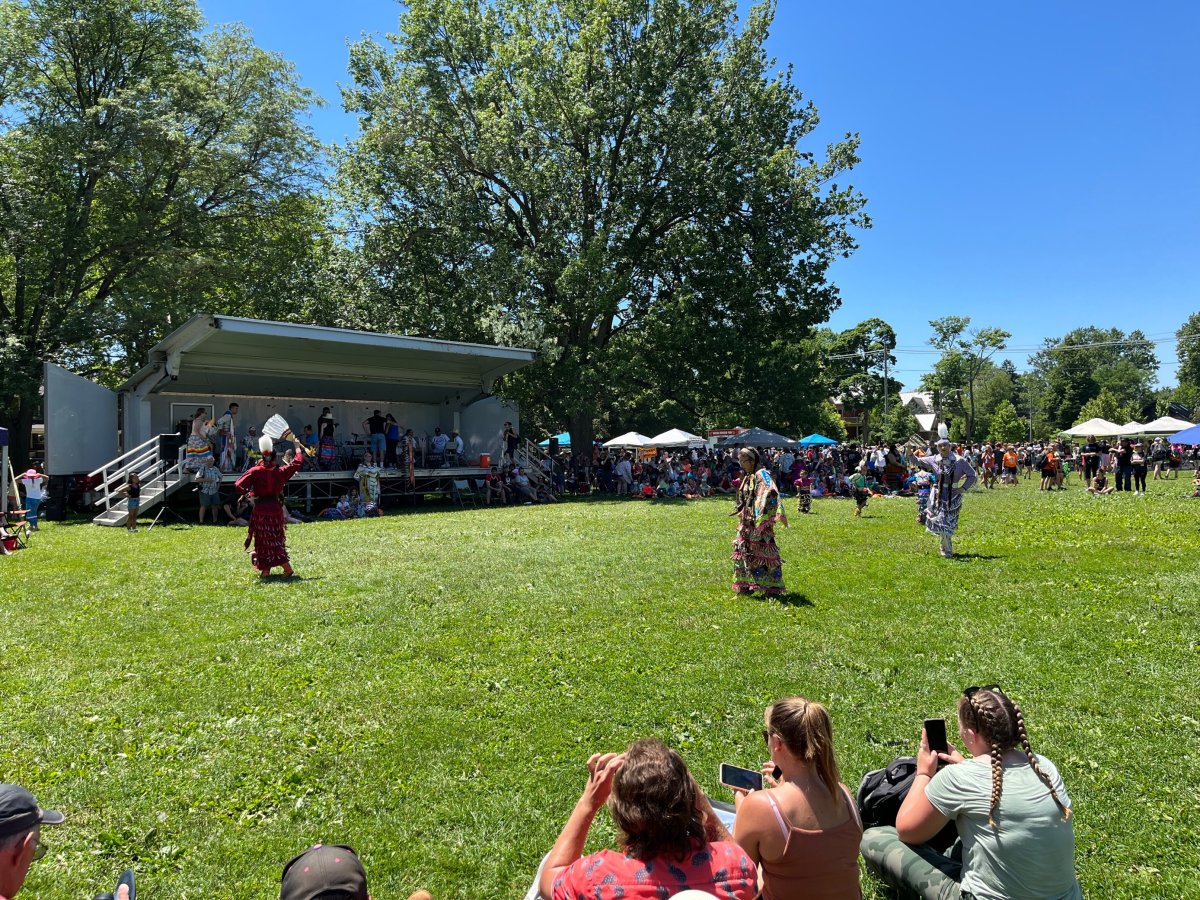Hundreds gathered on the Green in Wortley Village on Tuesday to mark National Indigenous Peoples Day in person for the first time since the COVID-19 pandemic began two years ago.

The day began with a sunrise ceremony at 6 a.m. followed by an afternoon on the Green, featuring singing, dancing, food, vendors and community service providers.
“It’s been a long couple of years with the lockdowns and whatnot, so it’s nice to be out here and celebrate with everybody here and enjoy dancing, singing and food and everything else that comes along with this powwow,” said attendee Jason Smith.
“To have everybody’s … positive energy, positive vibration and having a good time, seeing everybody’s smiling faces, not wearing a mask no more, that’s what it’s all about, just coming together and having a good time.”
The annual day, held every June 21, was first recognized in 1996 as a way to celebrate the contributions, cultures and heritage of First Nations, Inuit and Métis peoples.
Events are taking place across the country to mark the day, including the gathering in south London, organized by the Association of Iroquois Indians, Atlohsa Family Healing Services, N’Amerind Friendship Centre, Southwest Ontario Aboriginal Health Access Centre and the city.
“I’m seeing kids and neighbours and families that I haven’t seen in a long time. There’s so much growth that’s happened in the past few years, it’s crazy,” said Lacey Jackson of London’s Nshwaasnangong Child Care & Family Centre.
“I think the past couple of years have been really eye-opening for everything,” said Jackson. “I mean, first there were the 215 (unmarked graves) in Kamloops and more and more since then. But I think overall there’s been so much growth in our community and there’s so much positive change happening.
“I think, especially with Nshwaasnangong and having these children able to grow up in their culture, which is something a lot of us urban Indigenous people didn’t get the chance to do, I think it’s just onwards and upwards from here.”
The day is being seen in a new light this year following the discovery in Kamloops, B.C., along with further discoveries of unmarked burial sites at other former residential school sites in other provinces.
Ontario has said it believes there are likely more unmarked burial sites in the province than the 12 identified by the Truth and Reconciliation Commission, which documented abuse suffered by Indigenous children at residential schools and the deaths of more than 4,000 children.
Millions has been earmarked by the province for residential school burial site investigations, and earlier this month, the federal government appointed an independent special interlocutor to connect Indigenous communities dealing with the discovery of unmarked graves with the federal government.
For Sierra Jamieson, a jingle dancer and activist of Oneida Nation of the Thames, being able to take part in Tuesday’s event “means absolutely the world to me.”
“It’s so crazy to think that there’s still people out there who are willing to listen and willing to learn and willing to hear our stories, hear our truth,” Jamieson said.
“It’s so nice to see the outcome. I love all the youth that are here that are willing to participate in the intertribal who are willing to talk to us. It’s just really, really heartwarming to know that our community really has our back.”
Jamieson says she grew up watching powwow dancers and was “mesmerized by the movement and the regalia,” and taught herself. Growing up in London, she says she struggled with racism and sexism.
“I decided that it was time for me as an Indigenous woman to stand up and show that we’re more than just a racial stereotype.”
Jamieson says she began dancing with the Turtle Island Healing Walk last year, and says having the responsibility of healing the community takes a lot emotionally, mentally and physically.
One of her grandmothers, she says, was part of the residential school system, while the other was part of the ’60s Scoop, a child welfare practice from the 1950s to ’80s where Indigenous children were removed from their families and placed in non-Indigenous care.
“You’re pushing a lot of boundaries with those, and especially with the news of the 215 that happened last year, it was a time for Canada to wake up and it was a time for us to realize what the government and what the churches did,” she said.
“My mom actually told me that I’m one of the reasons why in our family I’m stopping that intergenerational trauma…. Being that voice and being that person that the youth can look up to and be like, ‘Hey, it’s OK to learn our culture and it’s OK to be proud of who we are.’ That’s pretty much the most rewarding thing that I can ever receive.”
Among the vendors on hand Tuesday was Three Sisters’ Beadwork, a small business run by three Indigenous women from three different nations.
“I’m personally from Six Nations of the Grand River, so just near Brantford, Kylie’s from Atikameksheng and Amber is from out East Coast so she’s Mi’kmaq,” said Mary Capton.
“We got our name basically from the planting methods of the Three Sisters — corns, beans and squash — and their planting method is they are very supportive of each other and they’re very intertwined.”
Capton says the launch of the business came close to the discovery last year of the unmarked graves in Kamloops. The three launched a fundraiser selling orange shirt pins and raised roughly $1,500 for a campaign by the Woodland Cultural Centre to “Save the Evidence” and restore the former Mohawk Institute Residential School.
“This year it’s going towards Indigenous climate action. That’s how we started getting into it. Once we were doing those and it got so much traction, we were like, ‘We should start a business.’ Amber suggested the name and we just started from there, it was really just grassroots,” Capton said.
Like Jackson, Jamieson and Smith, Capton said it was great to be back out with the community and to be able to see people again following the pandemic.
“Tons of new people, tons of community networking, especially after the pandemic, it’s really nice to be back with community as that’s a very core foundation for a lot of Indigenous communities,” Capton said.
“To be within the culture, be within the community and connect to each other…. It’s lovely to have those conversations and to see people again.”
According to the city, London is located on the traditional lands of the Anishinaabek, Haudenosaunee, Lūnaapéewak and Attawandaron. Treaties specific to this area include:
- Two Row Wampum Belt Treaty of the Haudenosaunee Confederacy/Silver Covenant Chain
- Beaver Hunting Grounds of the Haudenosaunee NANFAN Treaty of 1701
- McKee Treaty of 1790
- London Township Treaty of 1796
- Huron Tract Treaty of 1827, with the Anishinaabeg
- Dish with One Spoon Covenant Wampum of the Anishnaabek and Haudenosaunee.
— with files from The Canadian Press














Comments